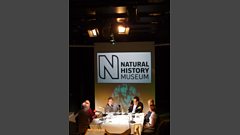Natural Symbols
In the final programme in the series, recorded in London's Natural History Museum, four experts from different fields choose an object that symbolises our relationship with nature.
In the final programme of the series a panel of experts from different disciplines choose an object they feel represents our relationship with nature. Recorded in the Natural History Museum in London in front of an audience Monty Don explores how our connection to nature has changed through time and what we may need to do to ensure we live on a vibrant planet in the future. The four guests from different areas of expertise from archaeology to conservation science to oceanography choose one thing that tells a big story. Monty Don explores how each object shows how our view of nature has changed since our time as hunter gatherers. Over the thousands of years we have lived on earth we have become increasingly divorced from the nitty gritty of the natural world. Where are we heading and what do we need to do to enable all of life to share this one planet? As population increases and stress on resources gets more intense there has never been a more important time to assess our impact on planet earth.
Last on
Dr Regan Early

has included , birds in the UK, butterflies in the mountains of Spain, and ducks in the Yukon Territory. However, she can often be found creating computer code that models biodiversity across the world, and calculates effective means of conserving it.
Twitter:
Dan Lafolley

His track record involves working with leading scientists to create initiatives that bring new knowledge into policy on issues such as coastal carbon sinks, climate change and ocean acidification. He has a broad knowledge of marine science matters across multiple disciplines and a track record of working with industry, especially with the energy sector.
°Õ·É¾±³Ù³Ù±ð°ù:Ìý
Professor Paul Pettitt

He has researched various aspects of the European Middle and Upper Palaeolithic and worked with numerous lithic assemblages, and on the dating of Neanderthal and early modern human remains. In 2003, he co-discovered Britain's only examples of Palaeolithic cave art at in the Midlands, and since then I've directed excavations at the Crags.
He has also co-directed excavations in the world famous site of with Mark White, with whom he also wrote The British Palaeolithic. In recent years he has been researching aspects of earlier Upper Palaeolithic hand stencils in the caves of France and Spain, and has collaborated on the dating of Spanish cave art, a project which has identified Europe's oldest securely dated examples of figurative and non-figurative cave art.
Professor Andy Purvis

He leads the PREDICTS project, which aims to build global models of how local terrestrial biodiversity responds to human impacts. He is also involved in the Museum’s digitisation programme, which aims to database 20 million of the Museum’s specimens within the next 5 years.
Broadcasts
- Tue 20 Jan 2015 11:00±«Óãtv Radio 4
- Mon 26 Jan 2015 21:00±«Óãtv Radio 4
Learn about habitats with The Open University
Explore the twists and connections of natural life in four different UK habitats.


